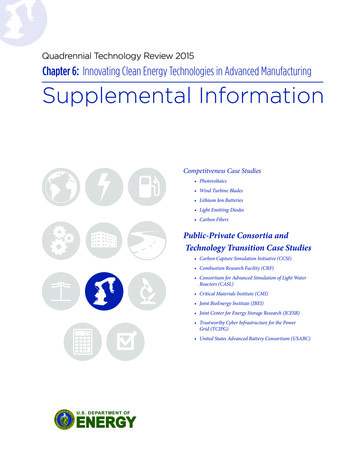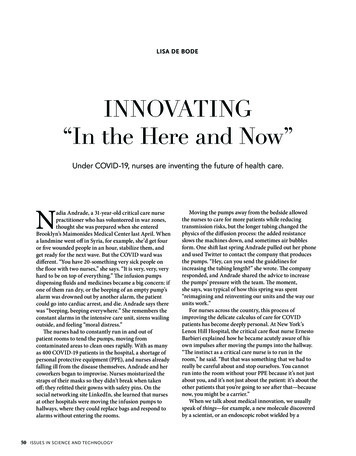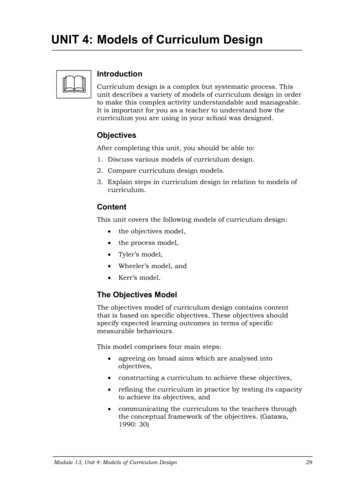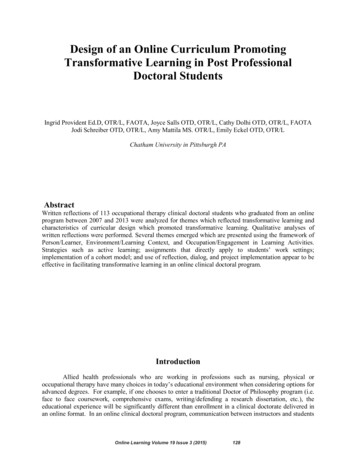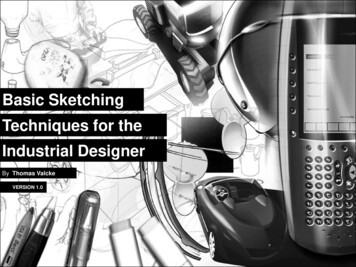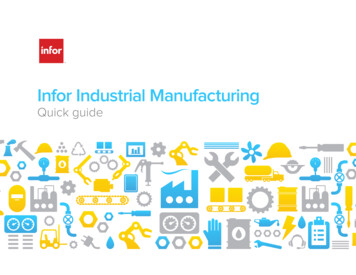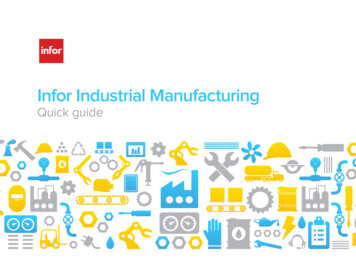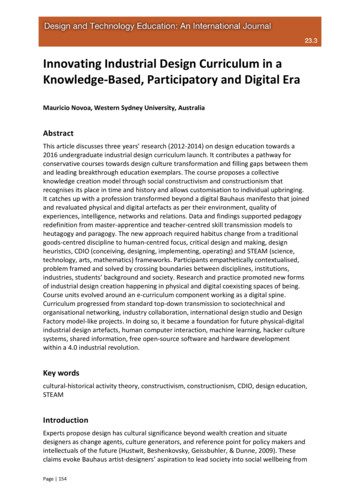
Transcription
Innovating Industrial Design Curriculum in aKnowledge-Based, Participatory and Digital EraMauricio Novoa, Western Sydney University, AustraliaAbstractThis article discusses three years’ research (2012-2014) on design education towards a2016 undergraduate industrial design curriculum launch. It contributes a pathway forconservative courses towards design culture transformation and filling gaps between themand leading breakthrough education exemplars. The course proposes a collectiveknowledge creation model through social constructivism and constructionism thatrecognises its place in time and history and allows customisation to individual upbringing.It catches up with a profession transformed beyond a digital Bauhaus manifesto that joinedand revaluated physical and digital artefacts as per their environment, quality ofexperiences, intelligence, networks and relations. Data and findings supported pedagogyredefinition from master-apprentice and teacher-centred skill transmission models toheutagogy and paragogy. The new approach required habitus change from a traditionalgoods-centred discipline to human-centred focus, critical design and making, designheuristics, CDIO (conceiving, designing, implementing, operating) and STEAM (science,technology, arts, mathematics) frameworks. Participants empathetically contextualised,problem framed and solved by crossing boundaries between disciplines, institutions,industries, students’ background and society. Research and practice promoted new formsof industrial design creation happening in physical and digital coexisting spaces of being.Course units evolved around an e-curriculum component working as a digital spine.Curriculum progressed from standard top-down transmission to sociotechnical andorganisational networking, industry collaboration, international design studio and DesignFactory model-like projects. In doing so, it became a foundation for future physical-digitalindustrial design artefacts, human computer interaction, machine learning, hacker culturesystems, shared information, free open-source software and hardware developmentwithin a 4.0 industrial revolution.Key wordscultural-historical activity theory, constructivism, constructionism, CDIO, design education,STEAMIntroductionExperts propose design has cultural significance beyond wealth creation and situatedesigners as change agents, culture generators, and reference point for policy makers andintellectuals of the future (Hustwit, Beshenkovsky, Geissbuhler, & Dunne, 2009). Theseclaims evoke Bauhaus artist-designers’ aspiration to lead society into social wellbeing fromPage 154
a century ago. Yet, today many designers lack the intellectual and commercial preparationto lead business, politics and social change. Numerous industrial design educations are stilllinked to specialised assembly and manufacturing, while higher education relies onmassification of teaching and strong preconditioning of outcomes for its survival. We live ina knowledge-based economy, decades after a digital Bauhaus manifesto that transferreddesign meaning from mass production to experience and knowledge creation. Timely, thisarticle discusses an undergraduate design degree makeover (2012-2014) which focuses onan individual and collective knowledge production model through social constructivism andconstructionism. It redefines design artefacts as tangible and intangible knowledge-basedcapital that realigns cultural, historical and spatial setting to address relationships betweenenvironment, people and technology. Design heuristics help overcome the physical-digitaldivide with empathy, contextualised human-centred and experiential design, and crossingboundaries between disciplines and participants. Social constructivism defines cognitiveprocesses as knowledge construction by learners through their own distinctive system ofknowing, making and modelling. Constructionism means the physical, digital and socialprocess by which those creations materialise through continuous conversation, interaction,critical design and making.Educational institutions play a pivotal role in the past and future of social development,whereas curriculum imparts discipline rules and prepare students for the profession.Course culture is thus determined within the push-pull between environment, people andtechnology that challenges established conventions (Figure 1). In particular, designcourses’ agency depends on innovation while still suffering unresolved dilemmas. Adefinitional crisis polarises programs between the extremes of artist-designer (inspiredcreative genius) and engineer-designer (scientific calculation resolving complicatedproblems). There is also a gap between well-funded benchmarks and design education thatfrequently struggles economically because of normative constraints and increasingPage 155
pressure towards massification of higher education. New, cheaper information andcommunication technologies (ICT) further redefine human relations, their space and timedimensions (e.g. face-to-face, mediated, distributed, augmented) while also replacingtraditional professions. Lastly, academia is experiencing rising demands to developcompetencies not available in standard design education (e.g. collective, creative,empathic). Fittingly, this research aims to answer: how can an industrial design curriculumenable participants’ knowledge construction to develop a design-driven innovation culturein a digital era? Supporting this, there are questions of how to:A. Update curriculum when design artefacts are no longer physical only?B. Diminish uncertainty and stimulate constructive collaboration?C. Bridge the physical-digital divide while transforming participants fromtechnology consumers to active cultural producers and mediators for socialbenefit?Figure 1: Environment, people and technology push-pull challenging design education.Reprinted from Author, 18 January 2012, Vision for Industrial Design Course:Presentation to Directors of Academics Program Panel, Unpublished internal document .MethodThis paper firstly uses epistemology to define and contextualise the challenge of industrialdesign in the current knowledge-based, participatory and digital era. Particularly, researchon theories of knowledge that look into what constitute a design artefact, its historicalcontext and effects on pedagogy. Cultural-historical activity theory was found to suit theprocess of course reformulation best. The paper then looks at the second step in thisproject that focused on a curriculum development that recognised education andtechnology benchmarks, and developed a new course with collaborative andinterventionist research approach to re-address design education for current times:ResultsEpistemologyThe Design ArtefactDesign artefacts have experienced semantic shifts alongside social and technologicalchanges. Industrial design has primarily persuaded society through physical artefacts.These were understood as objects (entities with purpose), as opposed to things (naturalentities independent from human intention or no longer serving function). Artefactsresulted from applying practical skill (Latin arte) to make well and good (facere) ‘manmade’ statements (factum). Social and material culture experts assumed them as tangible,ready-made and matters-of-fact (empirically measured) material properties capable ofinfluencing human behaviour. Yet, a design artefact is not just an artefact. It is also atechnical object. (Greek techne: crafted, manufactured, systematic). Concepts of truth,belief and socio-environmental connections affected how they carried knowledge.Originally, the English word for design came from old Greek past tense (eschein) for tohave or possess something. The embedded meaning was about loss of possession whichPage 156
required artefact representation to prevent humans from forgetting (Terzidis, 2007). ItsLatin root (de: out, signare: drawing a sign) meant marking to preserve mental images.Latour (2004); (2008) argues that design became exhausted last century as it turned intosuperficial stylistic representations (relooking) as veneers of fashion taste. He proposes aconstructivist approach redrawing two disconnected narratives together. One ofemancipation, detachment, modernisation, progress and mastery, and the othercompletely different of attachment, precaution entanglement, dependence and care infavour of redesigning effective nature and society ecosystems (e.g. climate change, equity,globalisation). Current problems are too multifaceted to condense as material matters-offact and input-output productivity. Design artefacts must transform from imagerepresentation to purposely constructed things capable of addressing matters-of-concern(undefined with relative implications) by appropriate processes that solve ambiguous andcomplex challenges.This curative design strength can help us re-evaluate artefacts beyond possession(consumption) and relooking (fashion) to re-seeing and seeing-through solutions forhumanity and nature as acts of iterative meaning construction. Consequentially, design isbetter defined with active verb expressions (e.g. making, modelling, testing) with non-finiteproperties in process of continuous development and interpretation. As with Dutchdescription (ontwerp), projected modelling inquires the present to improve future realitiesthrough research, collaborative and evolutionary improvements. Design education canfutureproof discipline and students by teaching design artefacts which are epistemicinstruments. They are characteristically fluid, non-static permeable and porous to theircontext, environment and users. A four knowledge construction periods timeline (Figure 2)assists understanding design artefacts’ past and future incarnations as:1.Product-Production: Craftsmanship representing inspiration on constructed (apriori) knowledge.2.Process-Method: Industrial and material applied research for forming and massproduction.3.People-Participation: Intricate challenges represented by people as consumers(e.g. behaviour, cognition), and the start of the electronic era (e.g. information,productivity, technology).4. Stages 1-3 are characterised by linear, simple and complicated problem-solvingneeding passive or restricted user operation to complete them (e.g. cars, chairs).5.Place-Time-Practice: Design artefacts as projects figuring out complexity and users(e.g. choices, decision-making, experience) through practice and forward(posteriori) knowledge construction in undefined environments. This requiresactive redesigning of artefacts as presentative platforms needing user interventionto generate and regenerate design (e.g. apps, coding, artificial entities).Characteristically, it involves co-creative and empirical habits based on empathy,discovery, participatory action research (PAR), modelling, and customisedforecasting and production. Since people can now design their own artefacts whileidentity and knowledge are easily reconfigurable through physical-digitalPage 157
materiality, spaces, time narratives, networks, cyber-culture, 4.0 industrialrevolution’s automation, generative design and artificial intelligence.Historical ContextMost industrial designers are Bauhauslers because of heritage. Bauhaus (1919-1933)merged art and technology to democratise industrialisation. Gropius’ manifestodenounced artists and designers as glorified craftsmen-decorators, and aesthetes whowere isolated from their socio-historical environment (Gropius, 1919). He opposedpedagogy’s (Greek paida: children, gogo: to lead) master-apprentice model that guidedpassive students via transmission and task replication (Herbart, 1806; Majorek, 1998).Bauhaus was influenced by other movements (e.g. Deutscher Werkbund,Novembergrouppe), intellectuals (e.g. Weber, Frankfurt School of Social Sciences) andDewey's re-imagining of learning as problem-based, hands-on, pragmatic education(Bergdoll & Dickerman, 2009; Dewey, 1902; Maciuika, 2005).A 6-year constructivist artist-designer syllabus consolidated industrial design past craftsand draughtsmanship into higher art by making it inseparable from research and socialimplication (Armengaud, 1853; Betts, 2004). Learners’ iterative trial-and-errorexperimentation heuristics (Greek heureskein), transformative dialogue, prototyping andtesting started from foundational analysis to nature, science (e.g. manufacturing,mathematics, geometry), comparative studies, and final specialisation. Unembellisheddesign artefacts were the archetypal integration of research science and visual arts, artistand machine aesthetics (Dondis, 1973; Saletnik & Schuldenfrei, 2013). Ground-breaking,Bauhaus-visible influence gave designers moral value with worth beyond productivity.Social change resulted from artefacts’ immediacy as “it is impossible to procure knowledgewithout the use of objects which impress the mind” (Dewey, 1975). However, Bauhaus didnot translate well elsewhere.Page 158
Figure 2: Industrial design’s four knowledge construction eras. Reprinted from Author, 27October 2014, Industrial Design Curriculum 2016: New Vision and Imperatives for theNew Normal of Innovation and its Education, Unpublished internal document.Mostly in post-war United States (U.S.) and United Kingdom (U.K.), many designers,educators and intellectuals tried to engineer society. As an example, the International Stylekept Bauhaus functionalism minus its social significance. Asemantic modernism rejectedordinary human, social and geographical interests. Government, corporate and educationprojects used design as instrument of control that befell users unable to connect with it.Experts predicated rationalistic methods would automatically make the world better bystringent procedures. Thus, design followed collected computing data, logical deductionand mathematical optimisation models (Miller & Tilley, 1984). Simon advocated artificialintelligence would do any work a man did within 20 years (Simon, 1969), whi
designers as change agents, culture generators, and reference point for policy makers and intellectuals of the future (Hustwit, Beshenkovsky, Geissbuhler, & Dunne, 2009). These claims evoke Bauhaus artist-designers’ aspiration to lead society into social wellbeing from . Page 155 a century ago. Yet, today many designers lack the intellectual and commercial preparation to lead business .
